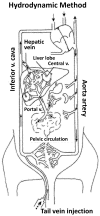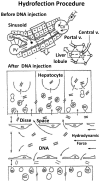Translational Advances of Hydrofection by Hydrodynamic Injection
- PMID: 29494564
- PMCID: PMC5867857
- DOI: 10.3390/genes9030136
Translational Advances of Hydrofection by Hydrodynamic Injection
Abstract
Hydrodynamic gene delivery has proven to be a safe and efficient procedure for gene transfer, able to mediate, in murine model, therapeutic levels of proteins encoded by the transfected gene. In different disease models and targeting distinct organs, it has been demonstrated to revert the pathologic symptoms and signs. The therapeutic potential of hydrofection led different groups to work on the clinical translation of the procedure. In order to prevent the hemodynamic side effects derived from the rapid injection of a large volume, the conditions had to be moderated to make them compatible with its use in mid-size animal models such as rat, hamster and rabbit and large animals as dog, pig and primates. Despite the different approaches performed to adapt the conditions of gene delivery, the results obtained in any of these mid-size and large animals have been poorer than those obtained in murine model. Among these different strategies to reduce the volume employed, the most effective one has been to exclude the vasculature of the target organ and inject the solution directly. This procedure has permitted, by catheterization and surgical procedures in large animals, achieving protein expression levels in tissue close to those achieved in gold standard models. These promising results and the possibility of employing these strategies to transfer gene constructs able to edit genes, such as CRISPR, have renewed the clinical interest of this procedure of gene transfer. In order to translate the hydrodynamic gene delivery to human use, it is demanding the standardization of the procedure conditions and the molecular parameters of evaluation in order to be able to compare the results and establish a homogeneous manner of expressing the data obtained, as 'classic' drugs.
Keywords: gene therapy; hydrodynamic; non-viral; translational.
Conflict of interest statement
The authors declare no conflict of interest.
Figures



Similar articles
-
Studying Closed Hydrodynamic Models of "In Vivo" DNA Perfusion in Pig Liver for Gene Therapy Translation to Humans.PLoS One. 2016 Oct 3;11(10):e0163898. doi: 10.1371/journal.pone.0163898. eCollection 2016. PLoS One. 2016. PMID: 27695064 Free PMC article.
-
Efficacy of interleukin 10 gene hydrofection in pig liver vascular isolated 'in vivo' by surgical procedure with interest in liver transplantation.PLoS One. 2019 Nov 5;14(11):e0224568. doi: 10.1371/journal.pone.0224568. eCollection 2019. PLoS One. 2019. PMID: 31689315 Free PMC article.
-
The mechanism of naked DNA uptake and expression.Adv Genet. 2005;54:3-20. doi: 10.1016/S0065-2660(05)54001-X. Adv Genet. 2005. PMID: 16096005 Review.
-
High volume hydrodynamic injection of plasmid DNA via the hepatic artery results in a high level of gene expression in rat hepatocellular carcinoma induced by diethylnitrosamine.J Gene Med. 2006 Aug;8(8):1018-26. doi: 10.1002/jgm.930. J Gene Med. 2006. PMID: 16779866
-
Hydrodynamic gene delivery: its principles and applications.Mol Ther. 2007 Dec;15(12):2063-9. doi: 10.1038/sj.mt.6300314. Epub 2007 Oct 2. Mol Ther. 2007. PMID: 17912237 Review.
Cited by
-
Codon Usage and Context Analysis of Genes Modulated during SARS-CoV-2 Infection and Dental Inflammation.Vaccines (Basel). 2022 Nov 6;10(11):1874. doi: 10.3390/vaccines10111874. Vaccines (Basel). 2022. PMID: 36366382 Free PMC article.
-
Transcutaneous ultrasound-mediated gene delivery into canine livers achieves therapeutic levels of factor VIII expression.Blood Adv. 2022 Jun 28;6(12):3557-3568. doi: 10.1182/bloodadvances.2021006016. Blood Adv. 2022. PMID: 35427415 Free PMC article.
-
Lipid-based Non-viral Vector: Promising Approach for Gene Delivery.Curr Pharm Des. 2025;31(7):521-539. doi: 10.2174/0113816128324084240828084904. Curr Pharm Des. 2025. PMID: 39318208 Review.
-
Early Subcellular Hepatocellular Alterations in Mice Post Hydrodynamic Transfection: An Explorative Study.Cancers (Basel). 2023 Jan 4;15(2):328. doi: 10.3390/cancers15020328. Cancers (Basel). 2023. PMID: 36672277 Free PMC article.
-
Novel vectors and approaches for gene therapy in liver diseases.JHEP Rep. 2021 Apr 30;3(4):100300. doi: 10.1016/j.jhepr.2021.100300. eCollection 2021 Aug. JHEP Rep. 2021. PMID: 34159305 Free PMC article. Review.
References
-
- Crepso J. Long-term expression of the human alpha1-antitrypsin gene in mice employing anionic and cationic liposome vectors. Biochem. Pharmacol. 1996;51:1309–1314. - PubMed
Publication types
LinkOut - more resources
Full Text Sources
Other Literature Sources

